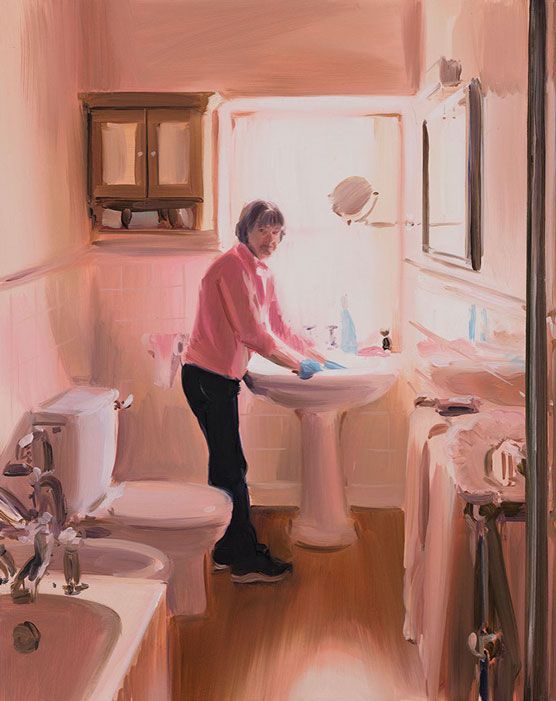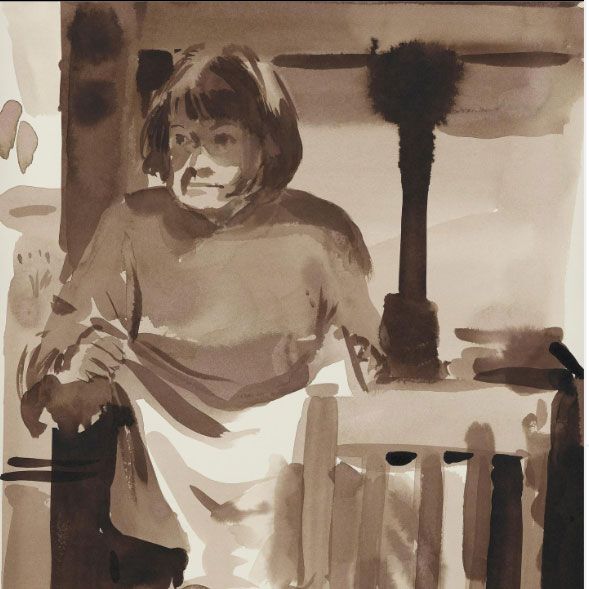“The subject of my paintings in its broadest sense is women’s experience, whether that is the imagined interior life of a glimpsed shop worker, a closely observed portrayal of my mother working in the family home, or women I’ve had the privilege of spending time within their place of work,” Walker explains. “From the anonymous to the highly personal, what links all these subjects is an investigation of an experience which is specifically female.” Through painting, Walker blurs boundaries between lived experience and objectivity, portraying a subject that is known to many.
Caroline Walker is a Scottish-born contemporary visual artist based in London, known for paintings of women, revealing the diverse social, cultural and economic experiences of her subjects living in contemporary society. A majority of her paintings reveal women performing unseen jobs, including housework and the routines of their domestic life.
As she draws the viewer into quiet moments and intimate scenes with striking realism, Walker challenges traditional ideas of women as subjects of art.

In an interview with Stephen Friedman Gallery, Walker shares her artistic process, specifically for her exhibition Lisa, which chronicles the daily life of her sister-in-law as she becomes a mother. She begins by following her subject, taking photographs of distinctive moments in her daily life. She then refers to these images to create pencil and charcoal drawings, technical compositions and oil sketches. Her paintings are then created freehand from the drawings and photographs.

Walker captures the transformations Lisa experiences from four weeks before delivery until the baby is three months old. Walker describes the works as combining “a factual record of something that [the source] photographs represent, and my memories or emotional response to being in a particular place or spending time with the people I paint.”

As an overarching theme, Walker is drawn to “invisible women,” rendered invisible by unpaid work in contexts such as “the care economy”: the activities that people, more often women, do on a daily basis, often in our homes, including housework or caring for others, such as infants or the elderly. Walker's art and subjects remind me of an impressive book published in 2019, Invisible Women: Exposing data bias in a world designed for men by Caroline Criado-Perez.
In this book, Perez investigates the root causes of gender inequality by diving into women's lives at home, in the workplace, in the public sphere, at the doctor's office and more. She discusses the concrete ways in which the places women inhabit on a daily basis are, more often than not, systematically designed for men. As a brief example, she outlines the way car crash test dummies are designed around a 50th percentile male and does not take into account women's anatomy, which contributes to the fact that women are 47 percent more likely to be seriously injured in a crash than a man.

Perez addresses topics more familiar to economists, including the failure to properly measure household chores and unpaid caregiving, the impact of taxes on women's choice to join the workforce, and the disproportionate representation of women among the world's poor. In her book, Perez reveals systematic flaws in GDP, the standard measure of a country's economy. It is estimated that unpaid work accounts for up to 50% of GDP in high-income countries and perhaps 80% in low-income countries.

This is the concrete subtext that can be observed in Caroline Walker's approach to this "invisible labour." The women in Walker's paintings are part of a much larger whole than the mere performance of household tasks. They are seen as forming a whole other economy that is being neglected and therefore Walker’s work is a clear example of art contributing the United Nations Sustainable Development Goal for Gender Equality, as well as Decent Work and Economic Growth.
Click here to follow Caroline Walker's work and view her website here.
